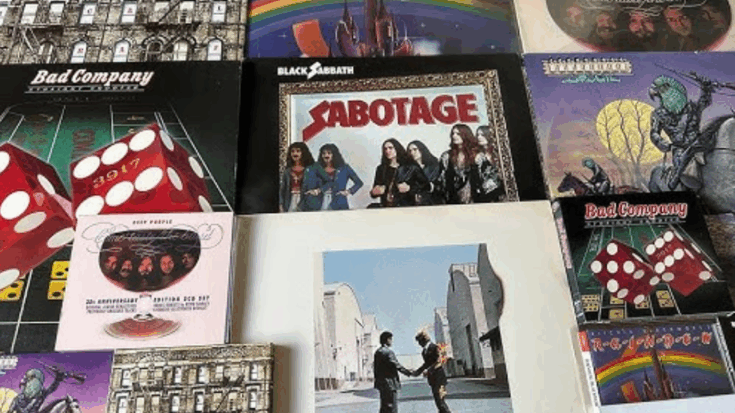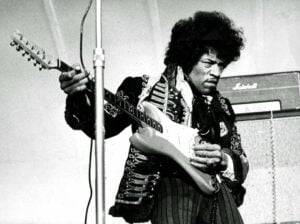50 Classic Rock Albums Turning 50 in 2025: Celebrating the Music of 1975

via Now Spinning Magazine / YouTube
Classic albums from 1975 continue to shape music today. These 50 landmark records that are now celebrating their 50th anniversaries. These albums show how artists grew, experimented, and influenced future musicians. These records changed the genre and rock scene forever.
Eagles – One of These Nights
Released in June 1975, this was the last Eagles album with the original lineup featuring Randy Meisner, Don Henley, Glenn Frey, Bernie Leadon, and Don Felder. Known for a smoother and more rock-driven sound, it includes their second #1 hit single.
It stayed atop the Billboard 200 for five weeks and sold over four million copies. The shift from country-rock set the stage for the massive success of their next albums.
Pink Floyd – Wish You Were Here
Released in September 1975, the album pays tribute to Syd Barrett’s struggles and criticizes music industry greed. It is known for its conceptual theme and the five-part “Shine On You Crazy Diamond.”
The sessions were difficult and reflected band stress early in the year. The album hit number one in both the U.S. and UK, becoming one of the most important works in the band’s catalog.
Led Zeppelin – Physical Graffiti
Released as a double LP in February 1975, this album includes tracks completed at Headley Grange and older recordings. The sleeve features NYC tenement imagery through die-cut windows.
It topped U.S. and UK charts and showed a wider musical range, from Arabic‑influenced epics like “Kashmir” to acoustic pieces. It sealed the band’s reputation as rock innovators.
Fleetwood Mac – Fleetwood Mac
Released in July 1975, this album introduced Lindsey Buckingham and Stevie Nicks, adding fresh songwriting and vocals. It is often called “The White Album” in the band’s catalog.
It eventually topped the Billboard 200 and marked a shift from blues into accessible rock/pop. Tracks like “Rhiannon” and “Monday Morning” showed early magic from the new line‑up.
Aerosmith – Toys in the Attic
Released in April 1975, this was Aerosmith’s breakthrough album. It featured hit singles “Sweet Emotion” and “Walk This Way,” both reaching high Billboard placement.
It sold over eight million copies and moved the band from opening acts to stadium headliners. The mix of rock, funk, and blues boosted their reputation.
Queen – A Night at the Opera
Released in November 1975, this fourth Queen album included the groundbreaking “Bohemian Rhapsody”. With a budget near £40,000, it was one of the most expensive albums at that time.
It went platinum in the U.S., sold over 11 million copies worldwide, and launched Queen to global stardom . Its layered vocals and varied styles highlighted the band’s range.
Bruce Springsteen – Born to Run
Released in August 1975, it took over a year to record and featured heavy piano use . The title track became an anthem defined by “Tramps like us, baby, we were born to run!”
The album launched Springsteen into mainstream fame after weak sales of his first two records. It peaked at #3 on the Billboard 200 and drew major media attention with a $250,000 Columbia campaign.
Heart – Dreamboat Annie
Released in 1975 through Mushroom Records, it was a debut success fueled by the Wilson sisters. Early sales came from fans buying the album from the trunk of their car.
The single “Crazy on You” got radio playing, and “Dreamboat Annie” became a hit single in 1976. The album’s mix of folk and rock made Heart a major band.
David Bowie – Young Americans
Recorded in Philadelphia 1974 and released 1975, the album showed Bowie‘s shift to soul-disco, with musicians like Luther Vandross contributing.
It features “Fame,” his first U.S. #1 single, co-written with John Lennon. The sound proved Bowie’s adaptability and influenced future pop styles. Though different from his glam past, it’s praised for its smart blend of genres.
Bad Company – Straight Shooter
Released late 1975, the album followed their self-titled debut. It featured strong songwriting from Paul Rodgers and Mick Ralphs, continuing their hard rock success.
It reached the Top 3 on the Billboard 200 and included hits like “Feel Like Makin’ Love.” The record reinforced their popularity in both U.S. and U.K. markets with consistent airplay.
Bob Seger – Beautiful Loser
Bob Seger returned to Capitol Records with Beautiful Loser, released in April 1975. He worked with the Muscle Shoals Rhythm Section for most tracks. It reached No. 131 on the Billboard 200 and showed Seger stepping into rock with more polish.
The album sold over two million copies in the U.S., earning 2× platinum status. Tracks like “Nutbush City Limits” with his Silver Bullet Band hinted at his future arena-rock success. It bridged his early work with the mainstream rock he’d later champion.
ZZ Top – Fandango!
Released in April 1975, Fandango! blends live and studio performances. Side one captures live shows from New Orleans, including a gritty version of “Thunderbird.” Side two features studio tracks like “Tush,” penned quickly during soundcheck.
The album hit No. 10 on the U.S. Billboard 200 and became a fan favorite . “Tush” reached No. 20 on the Billboard Hot 100, helping solidify ZZ Top’s blues‑rock sound. As Billy Gibbons explained, the half-live format “turned out to be a winning combination”.
Elton John – Captain Fantastic and the Brown Dirt Cowboy
Elton John’s Captain Fantastic and the Brown Dirt Cowboy, released in May 1975, was his first album to debut at No. 1 on the Billboard 200. The record is autobiographical, charting his and Bernie Taupin’s rise through music.
It represents a turning point, replacing earlier glam-rock style with more personal storytelling. The album includes singles like “Someone Saved My Life Tonight.” It earned critical acclaim and continues to reflect Elton’s evolving artistry, bridging his rock-pop roots with deeper lyrical focus.
Alice Cooper – Welcome to My Nightmare
Alice Cooper debuted his first solo album Welcome to My Nightmare in April 1975 . The record creates a theatrical rock experience, introducing the character Steven and guiding listeners through a spooky dream theme.
Featuring producer Bob Ezrin and a cast of guest musicians, it achieved platinum status. Tracks like “Only Women Bleed” remain staples of Cooper’s live shows. The album expanded his shock rock style into a more theatrical, narrative-driven format, influencing rock musicals and concept albums.
The Who – The Who by Numbers
Released in October 1975, The Who by Numbers reflected Pete Townshend’s introspection and personal doubts . The album front-loaded honest lyrics, moving away from their usual rock anthems.
It reached No. 5 in the UK and No. 8 in the U.S. charts. The singles “Squeeze Box” and “Slip Kid” got radio play, while deeper tracks showed the band grappling with fame and aging. This record showed a more thoughtful side of The Who, setting it apart in their catalog.
Paul Simon – Still Crazy After All These Years
Released in October 1975, this is Paul Simon’s fourth solo LP and his first to top the Billboard 200. The album includes four U.S. Top 40 hits: “50 Ways to Leave Your Lover” (No. 1), “My Little Town” (No. 9), “Gone at Last” (No. 23), and the title track (No. 40).
It earned two Grammy Awards in 1976. Simon wrote it reflecting midlife thoughts and relationships. He also reunited with Art Garfunkel on “My Little Town” and used the Muscle Shoals Rhythm Section on key tracks.
Foghat – Fool for the City
Released September 15, 1975, this album blends blues-rock with hard-boogie energy. It marked a milestone as Foghat’s first platinum album and included their signature hit “Slow Ride”.
Producer and bassist Nick Jameson recorded and co-wrote some songs. The album reached No. 23 on the Billboard 200 and elevated the band from regional to national fame .
Wings – Venus and Mars
Released in May 1975, this Paul McCartney-led band album followed the success of their first album and included the hit single “Listen to What the Man Said,” which reached No. 1 in the U.S.
While Venus and Mars didn’t dominate charts, it earned platinum status and marked a creative step that led into the Wings at the Speed of Sound tour.
Steely Dan – Katy Lied
Released in March 1975, this third album by Steely Dan features sophisticated writing by Donald Fagen and Walter Becker. It includes “Black Friday,” which reached No. 37.
Katy Lied built on the band’s blend of jazz, rock, and pop and helped define their sound. The album hit No. 13 on the Billboard 200 and earned gold certification.
Peter Frampton – Frampton
Released in February 1975, this album came before his massive live success. It contains early studio versions of songs later featured on Frampton Comes Alive!.
While not a major hit—peaking at No. 32—it showed strong guitar work and songwriting that led to his live breakthrough later that year.
Electric Light Orchestra – Face the Music
Released in September 1975, ELO’s fifth album explored themes of fame and electricity. It featured hits “Evil Woman” (No. 10 in the U.S.) and “Strange Magic,” boosting the band’s profile internationally.
It earned gold certification in the U.S. and reached No. 8 on the UK album charts, cementing ELO’s place in pop-rock.
Rush – Fly by Night
Released in February 1975, this is the first Rush album to feature drummer and singer Neil Peart . The songs included shorter, more melodic tracks, foreshadowing their style. Although it didn’t chart, the album earned gold status later. It showed growth beyond their debut’s hard rock focus.
Lynyrd Skynyrd – Nuthin’ Fancy
Released in March 1975, this third studio album came after the success of Second Helping. It includes tracks like “Saturday Night Special.” The album reached No. 9 on the Billboard chart and earned platinum certification.
It reinforced their Southern rock identity and set up their next tour and hits.
Chicago – Chicago IX: Chicago’s Greatest Hits
Released in May 1975, this compilation featured the band’s first major hits. It included new song “Wishing You Were Here” and reached No. 1 on the Billboard 200.
It became Chicago’s best-selling record and earned multiple platinum certifications. It acted as a summary of their early era.
Nazareth – Hair of the Dog
Released in March 1975, this album includes their hit title track with its famous guitar hook and backing vocals on “Love Hurts.” It became their most successful record, earning them international attention.
The album went gold in the U.S. and Canada, boosting Nazareth’s status in hard rock.
Styx – Equinox
Styx released Equinox on December 1, 1975, as their first record with A&M after leaving Wooden Nickel. The album introduced Tommy Shaw, who replaced guitarist John Curulewski and took over writing and vocal duties soon after release.
Though it reached only No. 58 on the Billboard 200, Equinox went gold in 1977. The hit single “Lorelei” became their second Top 40 track. The album’s mix of progressive and hard rock hinted at the style that would carry them forward, showing they could evolve without losing their core sound.
Bob Dylan – Blood on the Tracks
Blood on the Tracks, released January 20, 1975, marked Dylan’s return to Columbia Records. He began recording in New York in September, then re-tracked five songs in Minneapolis in December.
The album topped the Billboard 200 and went double platinum. It includes “Tangled Up in Blue” and “Shelter From the Storm.” Its lyrics blend heartbreak and reflection, inspired by personal events and short stories. Artists and critics often call it Dylan’s best work, and it was inducted into the Grammy Hall of Fame.
Bachman–Turner Overdrive – Four Wheel Drive
Released in July 1975, Four Wheel Drive was Bachman–Turner Overdrive’s third album. It became their first U.S. platinum record and featured the single “Hey You,” which reached the Top 40. The album kept their mix of rock and boogie strong, helping the band solidify its reputation.
It peaked at No. 18 on the Billboard 200. The band also toured extensively that year, bringing their heavy guitar-driven tracks live to fans. The album’s success showed they were no studio-only act and could maintain momentum after earlier hits like “Takin’ Care of Business.”
The Marshall Tucker Band – Searchin’ for a Rainbow
Searchin’ For a Rainbow, released July 1975, is The Marshall Tucker Band’s third studio album. It mixes Southern rock and country, featuring the popular title song that drew attention. The album reached No. 79 on the Billboard 200.
Led by guitarist Toy Caldwell, the record builds on earlier blues and jazz elements while expanding the band’s sound. It cemented their presence in the Southern rock scene and gave fans deeper insight into their musical range, balancing storytelling with instrumental skill.
Jefferson Starship – Red Octopus
Released July 1975, Red Octopus was Jefferson Starship’s second album after evolving from Jefferson Airplane. It topped the Billboard 200 and went double platinum. The hit single “Miracles” reached No. 3 and became one of the band’s most enduring songs.
The album blended soft rock and psychedelia, with smoother vocals from Grace Slick and new member Craig Chaquico on guitar. Its commercial success helped define the band’s new identity and brought them mainstream recognition in the mid-1970s.
Gary Wright – The Dream Weaver
Gary Wright released The Dream Weaver in July 1975. It stood out as one of the first rock albums built primarily on synthesizers, though also featuring bass, guitar, and drums.
Session musicians included Jim Keltner and David Foster. The title track hit No. 2 on the Billboard Hot 100 in early 1976, the first single issued, while “Love Is Alive” also reached that spot. The album itself peaked at No. 7 on the Billboard 200 and went double platinum. Its electronic sound influenced the synth-pop that followed, showing Wright’s experimental direction in rock.
Kiss – Alive!
Kiss released Alive! on September 10, 1975. This live double album was recorded between May and July across multiple concert venues. It was designed to capture the band’s high-energy show, which studio albums had failed to do. Overdubs and added crowd noise were included to enhance the experience, but fans responded well.
The album reached No. 9 on the Billboard 200 and stayed on the charts for 110 weeks. It earned gold status, and the live version of “Rock and Roll All Nite” became their first Top 40 hit, giving the band their breakthrough.
Rod Stewart – Atlantic Crossing
Rod Stewart released Atlantic Crossing in August 1975. He formed a new backing band in the U.S. and worked with writers like Jesse Ed Davis and Duane Allman. The album was first released as a double record in the U.K., then reworked as a single disc for the U.S., charting at No. 17.
It produced the Top 5 hit “Sailing” and became Stewart’s first U.K. No. 1 album. The record marked a turn toward softer rock and away from his earlier folk-blues style. It also solidified his solo career on both sides of the Atlantic.
Chicago – Chicago VIII
Released in March 1975, Chicago VIII continued the band’s string of Top 10 rock albums. It reached No. 12 on the Billboard 200 and went gold in the U.S. The album featured radio-friendly singles including “Brand New Love Affair” and “Harry Truman.”
Musically, it offered a mix of the group’s signature horns, rock riffs, and emotional themes, maintaining their mid-era style from previous releases. While not as ambitious as their earlier work, this album reinforced Chicago’s reputation for polished rock with brass. Its commercial performance kept the band riding high in the mid-’70s rock scene.
Jethro Tull – Minstrel in the Gallery
Jethro Tull released Minstrel in the Gallery in September 1975. The album balanced acoustic, blues, and hard rock elements while displaying Ian Anderson’s flute and songwriting. It reached No. 16 on the U.K. chart and No. 24 on the Billboard 200 in the U.S. Because the band was known for longer, progressive pieces, this album kept that while introducing more concise, band-focused songs.
It included varied textures, from the folk-blues title track to heavy tracks like “Jack in the Green.” The record reinforced Jethro Tull’s mix of rock and folk styles and secured their status among album-oriented listeners.
The Doobie Brothers – Stampede
Released April 25, 1975, Stampede marked the band’s fifth studio album. With Jeff “Skunk” Baxter joining as a full member and contributions from Ry Cooder and Curtis Mayfield, it mixed rock, funk, country, and folk. The album reached No. 4 on the US Billboard 200 and earned gold certification.
It yielded the Motown cover “Take Me in Your Arms (Rock Me)” which hit No. 11 on the Hot 100. It was the final Doobie Brothers album before Michael McDonald became lead singer.
Black Sabbath – Sabotage
Released in July 1975, Sabotage showed Black Sabbath pushing their sound in a heavier and more experimental direction. It featured complex arrangements, shifting tempos, and raw energy, all reflecting the band’s frustrations during legal battles at the time.
The album includes songs like “Symptom of the Universe” and “Hole in the Sky,” which combined aggressive riffs with darker, more emotional lyrics. Though it didn’t produce a major hit single, Sabotage reached No. 28 on the Billboard 200 and gained praise over time for its bold style and influence on early heavy metal.
Daryl Hall & John Oates – Daryl Hall & John Oates
Released September 1975, this seventh album added pop and rock into their R&B roots. It featured “Sara Smile,” their first Top 10 single in the U.S.
The album reached No. 17 on the Billboard 200 and was certified gold. It marked the first significant crossover hit for the duo, setting the stage for later mainstream success in the 1980s, blending melodic rock with blue-eyed soul.
Jeff Beck – Blow by Blow
Released March 1975, this solo album was produced by George Martin. It included no vocals and focused on jazz-rock fusion. The album peaked at No. 4 on the Billboard 200 and went platinum.
It featured Stevie Wonder’s compositions and keyboards by Max Middleton. Reddit users praised “Cascade” and “Cause We’ve Ended as Lovers” as benchmarks in fusion guitar playing.
The Outlaws – Outlaws
Released September 1975, debut album Outlaws introduced their brand of Southern rock. Featuring guitar duels and harmonies, it included tracks like “Green Grass and High Tides.” It reached No. 13 on the Billboard 200.
The album was certified Gold and helped define the band’s sound blending rock, country, and boogie. Its live versions of classic tracks have made it a staple on classic rock radio stations across the US.
John Lennon – Rock ’n’ Roll
Released in October 1975, this covers album featured 1950s rock classics like “Stand by Me” and “Be-Bop-A-Lula.” It was Lennon’s return from a hiatus and produced the single “Stand by Me” which charted in the UK and Canada .
Despite legal issues delaying release, the album reached No. 6 on the Billboard 200. It served as a tribute to rock’s roots and influenced later rock nostalgia through Lennon’s interpretations.
Elton John – Rock of the Westies
Released October 1975, this album was recorded in Los Angeles and featured hits like “Island Girl.” It was Elton’s fifth studio album of the year and peaked at No. 1 on the Billboard 200 .
The record earned platinum status and marked a shift from his British roots to a more American musical style. It captured a high point in Elton’s mid-70s output before personal changes altered his creative path.
America – Hearts
Released March 1975, Hearts featured the hit “Sister Golden Hair,” which reached No. 1 on the Billboard Hot 100 . The album also included “Daisy Jane,” a top-20 single.
It peaked at No. 12 on the Billboard 200 and was certified platinum. The record showed America refining its soft rock sound with smart songwriting and smooth harmonies, cementing their place in folk-rock history.
Neil Young – Tonight’s the Night
Recorded in 1973 and released June 1975, this album was a raw tribute to the losses of Danny Whitten and Bruce Berry. It captured their unreleased recordings with minimal editing.
Rather than success, it peaked at No. 18 on Billboard 200 and stunned fans with its dark tone. Over time it gained critical praise for its emotional honesty and influence on later introspective rock styles.
Grand Funk Railroad – Caught in the Act
Released April 1975, Caught in the Act was Grand Funk Railroad’s second live album. Recorded at Shea Stadium, it featured classic hits like “Some Kind of Wonderful.” It peaked at No. 16 on the Billboard 200.
It earned platinum status and showcased the band’s strong stage presence. The live set captured the energy of their concerts and kept Grand Funk relevant despite studio album fluctuations.
Bachman–Turner Overdrive – Head On
Released in December 1975, Head On was Bachman–Turner Overdrive’s fifth studio album, recorded at RCA Studios in Toronto. The album’s vinyl edition featured a large fold-out poster and included Little Richard on piano for “Take It Like a Man.”
Its single hit #33 on the Billboard Hot 100, while “Lookin’ Out for #1” reached #15 on Adult Contemporary charts. The album peaked at #23 in the U.S. and was the band’s last studio record to chart in the Top 40.
Bob Marley and the Wailers – Live! At The Lyceum
Recorded July 17–18, 1975, at London’s Lyceum Theatre, Live! captured Bob Marley & the Wailers during the Natty Dread tour. The album was released December 5 and features their hit “No Woman, No Cry (Live ’75).”
The live set helped bring reggae to global attention, becoming a significant release in Marley’s career. Critics praised the energy and audience connection, making it a landmark live album .
John Fogerty – John Fogerty
John Fogerty, released June 1975, marked the former CCR frontman’s solo debut. After leaving CCR, Fogerty wrote, produced, and performed most of the album himself. The record features tracks like “Rockin’ All Over the World,” though not the anthem by Status Quo.
It peaked at #78 on the Billboard 200 and launched his solo career. The album showed his commitment to the blend of rock and roots music that fans had loved, and it set the stage for his later solo success.
Linda Ronstadt – Prisoner in Disguise
Released October 1975, Prisoner in Disguise was Linda Ronstadt’s sixth studio album and second Platinum record. It included three Top 40 singles: “Love Is a Rose,” “Heat Wave,” and her version of Charlie Rich’s “Long, Long Time.”
The album reached #4 on the Billboard 200 and marked a shift from country-rock to R&B and pop standards. Critics praised her vocal range and song selection. It showed Ronstadt’s growing independence as an artist and helped solidify her position in 1970s music.
Various Artists – Tommy (Original Soundtrack Recording)
Released in September 1975, this soundtrack features performances from the film adaptation of The Who’s rock opera Tommy. It includes actors such as Roger Daltrey, Ann-Margret, and Oliver Reed performing key songs like “Pinball Wizard.”
The soundtrack reached #4 in the U.S. and was certified Gold. It provided new versions of tracks from Tommy, blending film and rock. The record brought The Who’s music to a wider audience and became a pop-culture milestone in its own right.












